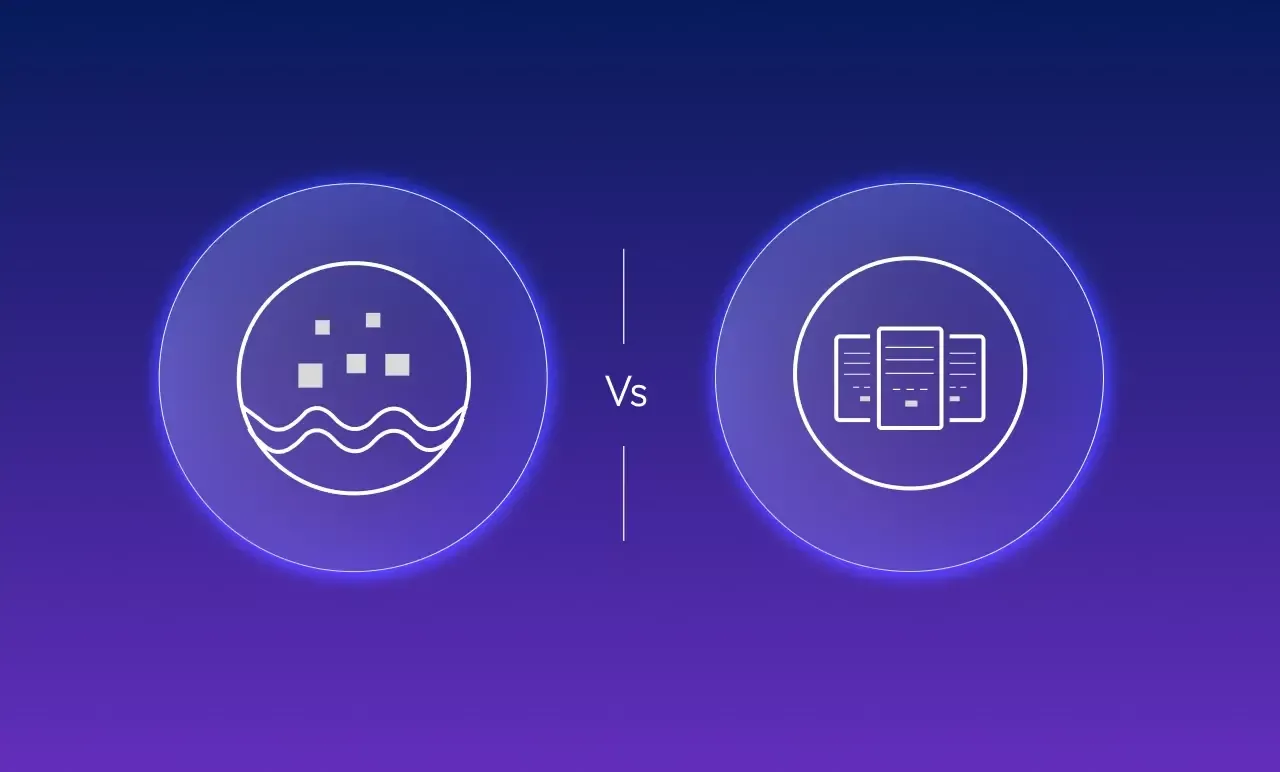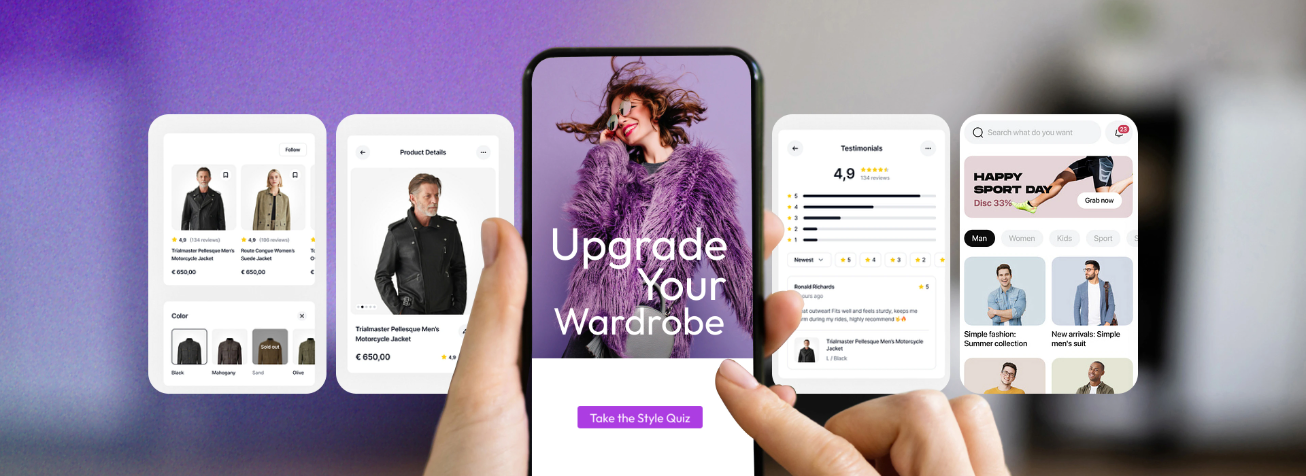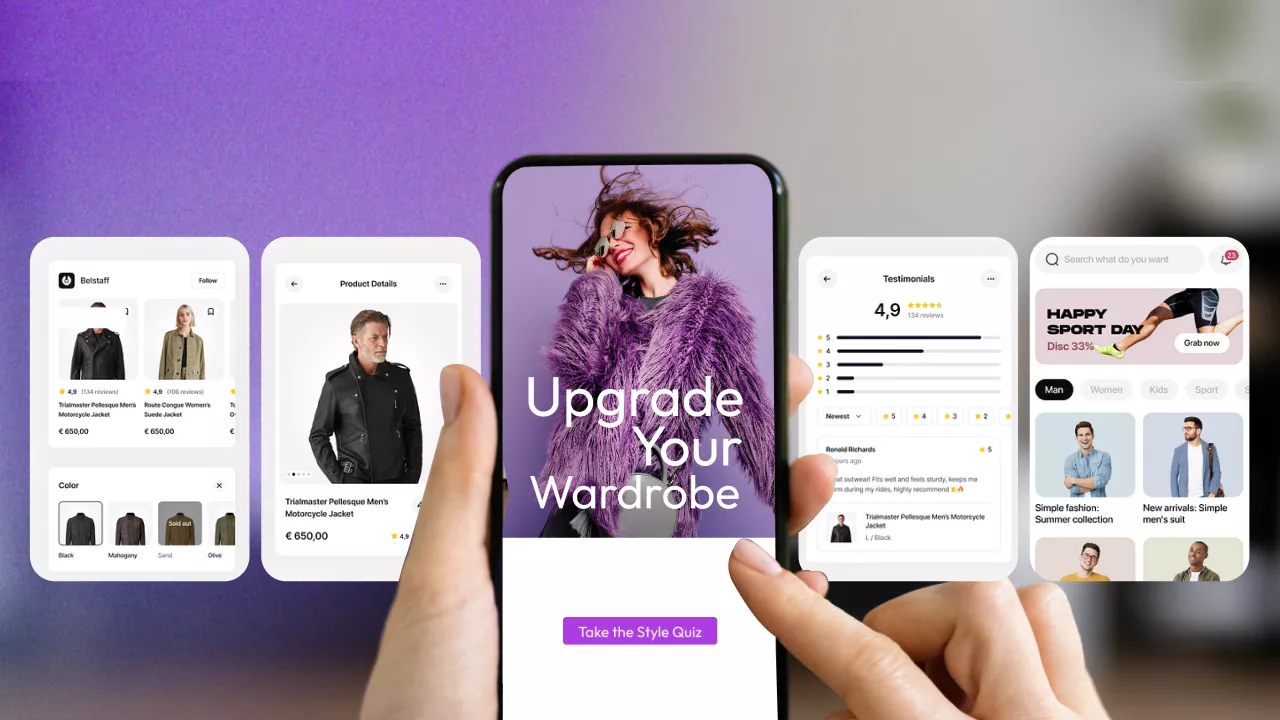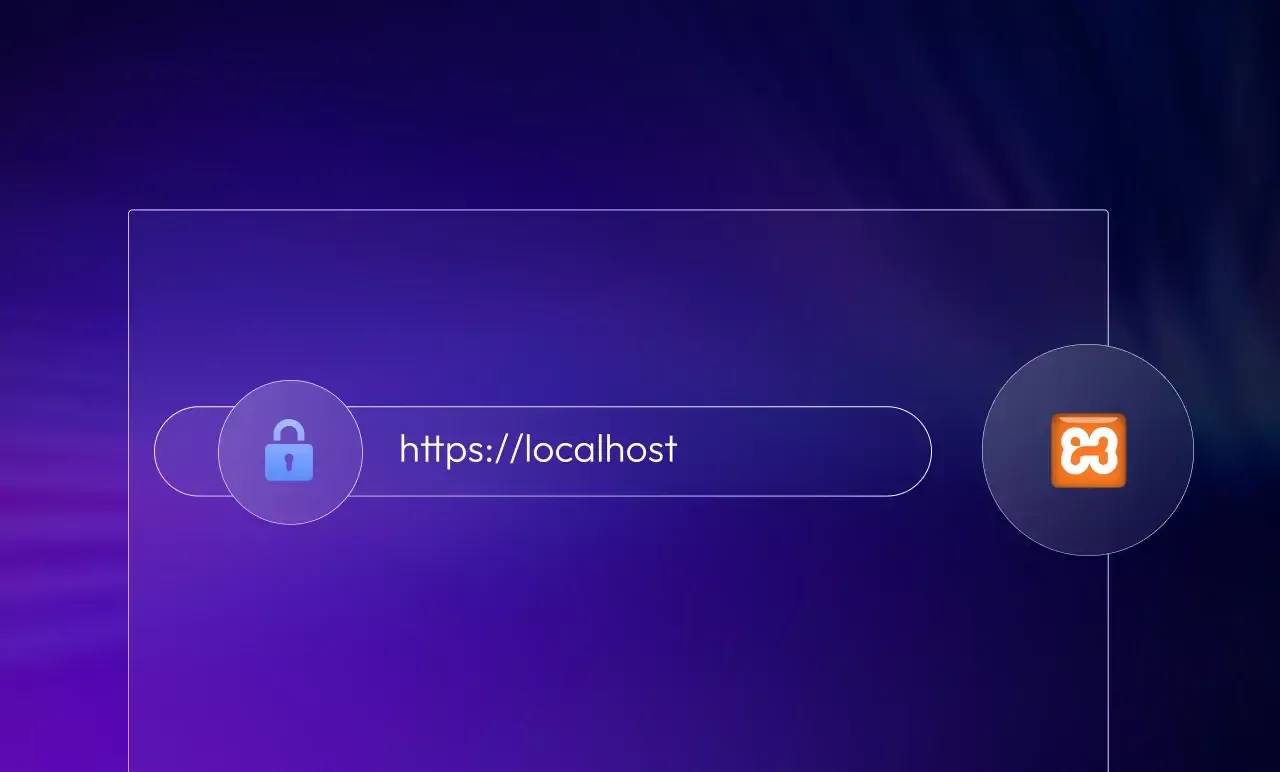Data Storage Decoded: Data Warehouse vs Data Lake Explained
The Ecom Store Launch Checklist: 6 Steps You Cannot Miss
So, you've got amazing products and a strong brand, and almost ready to launch your ecom store. But with the online shopping market becoming more saturated every day, how do you make your store stand out?
It’s not enough to simply shout louder than your competitors.
Consumers are more discerning—they want brands that they can connect with, and they want their shopping experience to be easy, seamless, and personalized.
Key Questions to Ask Before eCom store Launch:
Do you have a user-friendly web or mobile app?
Is your website or mobile app user-friendly?
Have you properly integrated payment gateways?
Do you have an efficient marketing strategy in place?
Ecommerce websites are essential for businesses of all sizes. From startups to large corporations, everyone wants to capture a piece of the online market. But, building an effective site requires careful planning.
Once live, your store needs to convert visitors into customers. Missing pieces, like payment gateways or confusing navigation, can lead to lost sales.
So, how do you avoid the losses and make the best out of your lot?
Here’s a roadmap to ensure your store is not just live but ready for success from day one!
Why Do You Need an Ecom Store?
An e-commerce or ecom online store serves as your business’s virtual storefront, providing customers with the convenience of shopping anytime, from anywhere.
It's more than just a website. It’s a powerful tool for modern brands to connect with their audience, drive sales, and stay competitive.
As more consumers shift from traditional stores to online shopping, having an ecom store has become essential for businesses seeking to expand their reach and meet the evolving expectations of today's shoppers.
From small independent retailers to global brands, e-commerce is the key to accessing new markets, satisfying customer demand, and fueling growth in ways traditional retail simply can't match.
In today’s digital economy, investing in an ecom store is crucial for staying relevant and ahead of the competition.
How Do You Set Up Your First Ecommerce Store?
To help businesses navigate this crucial phase, here’s a comprehensive ecom store checklist. It will help you make sure you’re headed the right way.
Step 1: Choosing the Right Technology
When developing your eCommerce website and mobile app, selecting the right platform is crucial.
The technology you choose directly impacts user experience, scalability, and your ability to meet business goals.
We have broken down three popular options—WordPress, Laravel, and MERN Stack with Next.js—each catering to different business needs.
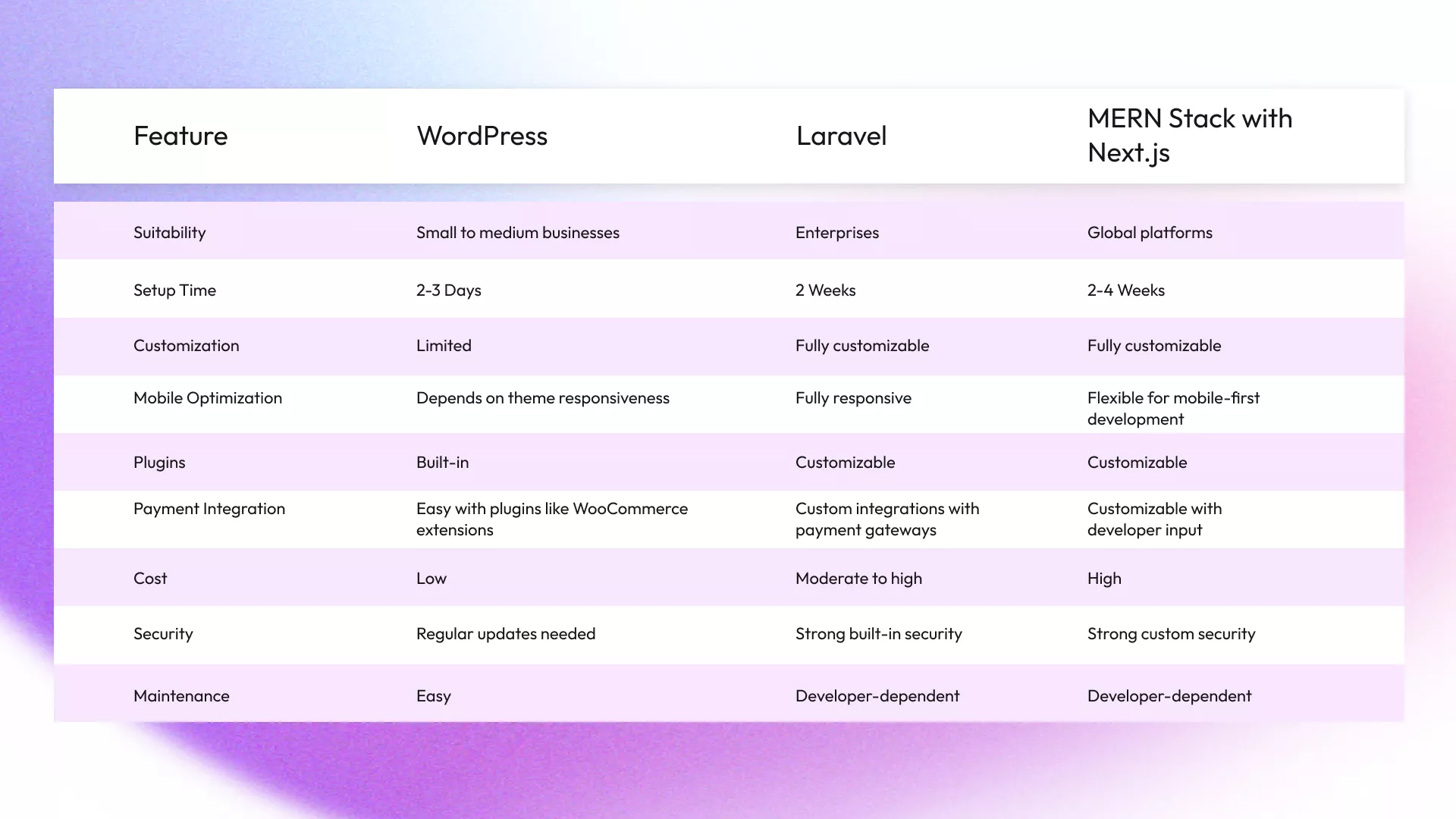
WordPress: The Accessible All-Rounder
Advantages of using WordPress to build an ecom online store:
- Ease of Setup: WordPress is beginner-friendly, with minimal technical expertise required to build and launch an e-commerce site.
- Rich Plugin Ecosystem: WooCommerce and other plugins provide extensive functionality for payment, shipping, analytics, and more.
- Quick Launch with Themes: Thousands of pre-built themes allow businesses to create professional-looking websites rapidly.
- Strong SEO Capabilities: Built-in SEO tools and plugins like Yoast make WordPress an excellent choice for content-driven e-commerce sites.
- Cost-Effective: Perfect for startups with limited budgets due to its free core system and many low-cost plugins and themes.
Best For:
- Small Businesses: Entrepreneurs and startups needing a quick and affordable online presence.
- Content-Focused Sites: E-commerce stores that heavily integrate blogs or guides as part of their marketing strategy.
Laravel: The Customization Powerhouse
Laravel is another framework that can be considered when choosing the right technology when building your ecommerce launch checklist.
Advantages of using Laravel to build an ecom online store:
- Complete Flexibility: Laravel enables businesses to design highly customized e-commerce workflows and features.
- Built for Complexity: Ideal for advanced requirements, like multi-vendor marketplaces or unique payment and shipping systems.
- Scalable Performance: Optimized for large-scale operations with features like caching and efficient database management.
- High Security Standards: Includes built-in tools to protect against common vulnerabilities like CSRF attacks and data breaches.
- API-Ready: Excellent for integrating with mobile apps or external services via RESTful or GraphQL APIs.
Best For:
- Enterprise-Level Stores: Businesses planning for growth and needing custom solutions to meet their unique demands.
- Innovative Workflows: Companies requiring advanced e-commerce setups that standard platforms cannot provide.
MERN Stack with Next.js: The Modern Solution
Advantages of using MERN Stack with Next.js to build an ecom online store:
- Cutting-Edge Technology: Combines MongoDB, Express.js, React.js, and Node.js for building high-performance web apps.
- Speed Optimization: Server-side rendering (SSR) with Next.js ensures fast page loads and excellent search engine visibility.
- Dynamic User Experiences: Perfect for personalized features like product recommendations, live updates, and interactive UI components.
- Streamlined Development: A single programming language (JavaScript) for both front-end and back-end simplifies development and reduces technical debt.
- Tailored Functionality: Building from scratch means the system includes only what’s needed, avoiding unnecessary bloat for optimized performance.
Best For:
- Tech-Driven Startups: Companies focused on delivering modern, dynamic, and innovative user experiences.
- Large-Scale Platforms: Businesses with advanced scalability requirements, such as high traffic, real-time updates, or multi-regional stores.
- Custom Feature Demands: Enterprises seeking a fully bespoke e-commerce platform with integrations and functionalities tailored to their unique needs.
By aligning your choice of technology with your business goals, technical expertise, and scalability needs, you can ensure a strong foundation for your e-commerce success.
Step 2: Responsive Design and User Experience
When gearing up for your ecom launch, it's essential to check that the site adapts smoothly to various screen sizes.
From smartphones to tablets and desktops, your users should enjoy a consistent, intuitive browsing experience no matter how they access your site.
Why Responsive Design Matters:
- A fast-loading website is critical for maintaining a competitive edge. Slow loading times can lead to higher bounce rates and lost sales, particularly on mobile devices, where users are less likely to wait for a page to load.
- Studies show an 8% increase in conversions with a reduction in mobile site speed by 0.1 seconds. This means ensuring your site loads quickly and looks great on any screen—it’s a key driver of sales.
- Prioritize a responsive web design to create a seamless experience across all devices. This will help you accommodate the increasing number of mobile users who expect an effortless shopping journey. In fact, mobile-first design is no longer just a trend—it’s a necessity.
- Small design flaws can lead to big problems, so routine testing is a vital part of your website maintenance. To keep everything in sync, make sure to test your site regularly across different devices and browsers. This will help you identify and resolve any issues before they negatively impact the user experience.
- In addition to a smoother user experience, faster load speeds also improve your SEO rankings, which in turn drives more traffic to your site. To ensure your site performs at its best, invest in secure, reliable hosting and focus on optimizing your site speed. Tools like image compression, caching, and reducing unnecessary scripts can significantly improve load times.
Step 3: Product Integration for Inventory Management
Connecting the right systems with your e-commerce platform is essential to gathering, storing, and utilizing data effectively.
For instance, integrating effective inventory management tools can help:
- Track stock levels
- Alert you to restocking needs
- Ensure product availability
This will allow your customers to enjoy a seamless shopping experience.
Step 4: Payment Gateways
Similarly, an ecommerce store is no better than any local store without efficient shipping solutions and flexible payment gateways.
Another crucial factor in boosting delivery efficiency and customer satisfaction is reliable shipping integrations, which provide features such as:
- Real-time tracking
- Automated label generation
Additionally, a user-friendly checkout experience is vital for converting browsers into buyers. You can choose from a variety of trusted payment options, including:
- Credit cards
- PayPal
- Apple Pay
- Amazon Pay
- Stripe
This way, you'll be catering to diverse customer preferences and boosting conversion rates.
By focusing on security, transaction fees, and ease of integration, businesses can ensure a smooth payment process that minimizes cart abandonment. It also enhances overall customer satisfaction, improving the shopping experience and fostering loyalty.
Offer multiple contact options like email, phone, and live chat. Plus, respond quickly to build trust and ensure a positive shopping experience.
Step 5: Marketing Essentials for Your Ecom Store
Search engine optimization is essential for visibility. Optimize your product pages with relevant keywords, meta tags, and quality backlinks. Support this with engaging product descriptions, images, and videos. These will highlight features and benefits, enhancing both search rankings and customer engagement.
Utilizing platforms like Instagram, Facebook, and TikTok is key for e-commerce. Develop impactful social media content with the help of digital marketing experts. From product highlights to ads, ensure brand consistency and customer interaction across channels.
Step 6: Continuous Optimization for Enhanced Customer Experience
While the drive to achieve an online storefront launch fast is understandable, ensuring the site runs efficiently is even more crucial for staying ahead of competitors
For a successful ecom online store, seamless navigation and ease of purchase are essential. Conducting regular user testing feedback helps ensure that your site is continually improving.
Integrating AI-driven product recommendations in retail adds a personalized touch, encouraging customer engagement.
To refine your store’s performance, track key metrics like conversion rate, bounce rate, and customer lifetime value. With data-driven adjustments, you can better meet customer needs and adapt to trends.
Businesses can get tools and support to interpret these insights for targeted improvements. Plus, they can create tailored suggestions based on user behavior and preferences.
Trends and Best Practices for Ecom Store Success
Mobile Shopping Experience
Mobile shopping now accounts for a large portion of online purchases, contributing to 67% of all e-commerce sales.
So, opting for mobility solutions is no longer optional—it’s essential.
Ecom stores with mobile-first design ensure that all elements, from product images to checkout buttons, are user-friendly on smaller screens, offering seamless navigation and faster load times.
Features like mobile-responsive themes and accelerated mobile pages (AMP) can improve both performance and search rankings. A streamlined mobile user experience boosts customer retention and minimizes cart abandonment.
Sustainability in E-commerce
Consumers today increasingly value eco-friendly practices, which can greatly impact brand perception.
Sustainable practices like eco-friendly packaging, carbon-neutral shipping options, and clear sustainability commitments can differentiate a brand.
It also demonstrates a commitment to reducing environmental impact. Brands now see sustainable practices as integral to building loyalty and a positive brand reputation.
This makes green shipping options, recycling initiatives, and reduced plastic packaging essential items in an ecommerce website launch checklist to attract eco-conscious shoppers.
Voice and Visual Search
Voice and visual search technologies are reshaping how consumers find products.
Voice search, often facilitated by smart assistants like Alexa and Google Assistant, offers hands-free convenience. This is expected to transform search behavior.
Visual search, using AI to analyze images for relevant products, simplifies the search process for users who might not know exact search terms.
Optimizing for these technologies can enhance visibility. It also makes product discovery easier, ultimately boosting conversions.
On an ending note…
Launching an ecom store can feel overwhelming. However, with a clear plan and the right support, it’s achievable.
Streamline this journey with the help of Sundew and get guidance from tip to toe. Be it choosing the ideal platform, securing a domain, or designing product pages with optimized content, we're with you. Get help setting up secure payment options and customer support tools to ensure you attract and retain loyal customers.
With Sundew's end-to-end support, you’re set to create a high-performing ecom online store that’s ready for long-term growth!
Email us or Talk to us at +91-98367-81929 or Simply Contact Us through the website.
Let's Connect


